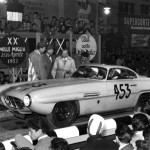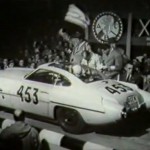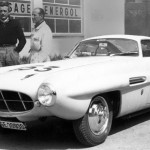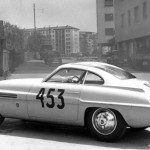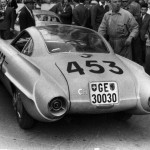Alfa Romeo – Conrero 1900 Ghia Supersonic 1953
IDEE SUPERSONICHE. RISALE AL 1953 LA PRIMA FORMA “SUPERSONIC” CREATA DA GHIA DI TORINO
Il primo esempio in assoluto della carrozzeria Supersonic sviluppato dalla Ghia si deve alla commissione dello svizzero Robert Fehlmann, che nel 1953 ordinò una carrozzeria speciale all’azienda torinese per la sua Alfa 1900.
l’ingegner Giovanni Savonuzzi, già autore della carrozzeria della Cisitalia 202 con le famose pinne posteriori, portò alle massime conseguenze il suo estro creativo e inventò uno stile futurista e innovativo.
Per il telaio, ugualmente, non si risparmiò attingendo a piene mani ad altre meccaniche: in particolare per l’anteriore alla Fiat 1400 (sospensioni) e per il posteriore (trasmissione) alla Lancia Aurelia.
Al noto preparatore Virgilio Conrero fu quindi affidato l’incarico di preparare il motore Alfa in vista della Mille Miglia del 1953.
Partito dalla pedana di Viale Venezia alle 4:53 del 26 aprile 1953 (la corsa fu vinta dal Conte Giannino Marzotto, vestito in doppio petto, sulla Ferrari 340 MM Barchetta Vignale numero di gara 547) la vettura fu costretta al ritiro per incidente.
Riportata a Torino, fu riparata e ricevette una nuova carrozzeria, completamente differente, questa volta in forma di barchetta Sport due posti.
La carrozzeria Supersonic, nondimeno, fu ampiamente apprezzata. Si possono considerare numerosi altri esempi di fuoriserie carrozzati su altri telai (circa 20): 3 esemplari su meccanica Jaguar XK120, almeno 8 esemplari su Fiat 8V (a cui si aggiungono altri telai, per un totale di circa 15 unità), 1 Aston Martin DB2 e la DeSoto Adventurer II concept, carrozzata dalla stessa Ghia nel 1954.
CARROZZERIA GHIA
Giacinto Ghia fondò a Torino il suo atelier di carrozzeria nel 1915 dedicandosi alla costruzione di carrozzerie leggere (l’Alfa Romeo 6C 1500 vincitrice della Mille Miglia del 1929 aveva una carrozzeria Ghia).
A cavallo delle due guerre, lo specialista torinese si distinse nella produzione di carrozzerie per Fiat, Alfa e Lancia. Ma nel ’43 un bombardamento distrusse lo stabilimento e tutte le attrezzature. Si disse quel tragico evento minò il fisico di Giacinto Ghia, cui l’anno seguente fu fatale un attacco cardiaco.
La moglie Santina fu determinata nel desiderare che l’attività della carrozzeria continuasse e trovò in Felice Mario Boano la persona giusta per continuare l’attività del marito.
Con Boano l’azienda riprese il volo e si aprì al mercato internazionale (nel ’53 disegnò la carrozzeria della Volkswagen Karmann-Ghia, nel ’51 iniziò la collaborazione con Chrysler).
Il business si ampliò con il passare del tempo e, nonostante la cessione della proprietà al Direttore Generale Luigi Segre (Boano lasciò l’azienda nel ’54 per fondare la Boano Lavorazioni Speciali), nel ’57 acquisì gli stabilimenti della Frua e arrivò, all’inizio degli Anni ’60 a dimensioni quasi industriali.
Il business era diversificato: dall’allestimento di esemplari unici per clienti speciali (Scià di Persia, Juan Peron, Tito, Sukarno, lo sceicco del Kuwait, il regista Rossellini, Totò), alla progettazione di design per i marchi costruttori (Chrysler 300, Chrysler Newyorker, Volvo P1800, Renault Floride…) all’assemblaggio di carrozzerie per altri marchi.
Per quest’ultimo scopo, nel 1960 viene fondata la OSI (Officine Stampaggi Industriali), che dopo due anni divenne un’azienda indipendente con 650 dipendenti e una capacità produttiva di 50 auto al giorno. Da qui uscirono le Innocenti 950 spider, le Fiat 1300 e 1500 familiari e le Fiat 2300 S.
Tra le vetture più conosciute che nacquero in questo periodo grazie alla Ghia vi sono la Plymouth Barracuda 450 SS, la De Tomaso P70 e la Mangusta, la Bugatti 101 C. Auto più o meno acclamate come capolavori dello stile, e che dal ’65 portarono la firma di un grande del settore, Giorgetto Giugiaro.
Nel 1967, dopo alcuni passaggi di proprietà, tutto il pacchetto azionario della Ghia viene rilevato dalla Rowan Controller Co. di Westminster nel Maryland. Alejandro De Tomaso assunse la carica di Amministratore Delegato. Sotto la sua direzione gli stabilimenti furono ammodernati e potenziati con l’aggiunta di un nuovo impianto automatizzato per la verniciatura delle scocche; nacquero lo stile della Iso Rivolta Fidia ma, soprattutto, della Maserati Ghibli.
Nel 1970 la Rowan cedette l‘80% delle azioni alla Ford e il 20% a De Tomaso. Questi mantenne la carica di AD fino al ’72, anno in cui la Ford divenne proprietaria del 100%. La prima auto della nuova gestione fu una supercar destinata a fare storia: la De Tomaso Pantera.
Dal ’72 gli stilisti della Ghia sono alle dipendenze dirette della Ford. Oggi il nome Ghia è diventato il simbolo di riconoscimento delle versioni “speciali” dei modelli Ford della produzione in serie.
SUPERSONIC IDEAS. THE FIRST “SUPERSONIC” TYPE BY GHIA IN TURIN DATES BACK TO 1953.
The first ever example of Supersonic bodywork made by Ghia is due to the Swiss Robert Fehlmann, who in 1953 ordered a special bodywork at the company in Turin for his Alfa 1900. Engineer Giovanni Savonuzzi, already author of the Cisitalia 202 bodywork with its famous tail fins, got the most out of his creativity and invented a futuristic and innovative style. Also as for the chassis, he did not spare himself any effort drawing liberally to other mechanics: in particular for the front side of the Fiat 1400 (suspensions) and the rear side (transmission) for the Lancia Aurelia.
The well-known mechanic Virgilio Conrero was then given the task to prepare the Alfa engine in view of the Mille Miglia in 1953. Started from the platform in Viale Venezia at 4:53 a.m. on April 26, 1953 (the winner was the Count Giannino Marzotto, double-breasted, on the Ferrari 340 MM Barchetta Vignale race number 547) the car was forced to retire due to an accident. Once brought back to Turin, it was repaired and received a new bodywork, completely different, this time in the form of two-seater barchetta Sport. The Supersonic bodywork, however, was widely appreciated. You can consider several other examples of custom-built bodywork on other chassis (about 20): 3 models on Jaguar XK120 mechanics, at least 8 models on Fiat 8V (in addition to other chassis, for a total of about 15 units), 1 Aston Martin DB2 and the DeSoto Adventurer II concept, with bodywork made by Ghia itself in 1954.
GHIA BODYWORK
Giacinto Ghia founded his own bodywork company in Turin in 1915, devoting himself to the light bodywork building (the Alfa Romeo 6C 1500 Mille Miglia 1929 winner had a Ghia body). Between the two wars, the specialist from Turin excelled at producing bodies for Fiat, Alfa and Lancia. But in ’43 a bombardment destroyed the factory and all the equipment. It was said that tragic event undermined Giacinto Ghia’s health, who died of a heart attack the next year. His wife Santina was resolute to continue the bodywork business and she found the right person in Felice Mario Boano to continue her husband’s work.
Thanks to Boano, the company flew high again and opened to the international market (in ’53 he designed the Volkswagen Karmann-Ghia bodywork, in ’51 he began working with Chrysler). The business was expanded as time went by and, despite the sale of the property to the Director-General Luigi Segre (Boano left the company in ’54 to found the Boano Lavorazioni Speciali), in ’57 he acquired the Frua factories and reached, at the beginning of the 60’s, almost industry size. The business was diversified: from unique models for special customers (the Shah of Persia, Juan Peron, Tito, Sukarno, the Sheikh of Kuwait, the director Rossellini, Totò), to design planning for manufacturers brands (Chrysler 300, Chrysler Newyorker, Volvo P1800, Renault Floride …) to assembly of bodies for other brands.
As for the latter purpose, in 1960 it was founded the OSI (Officine Stampaggi Industriali), which two years later became an independent company with 650 employees and a production capacity of 50 cars per day. The Innocenti 950 Spider, the Fiat 1300 and 1500 family and the Fiat 2300 S came from there.
Among the most well known cars which were born in that period thanks to the Ghia there are the Plymouth Barracuda 450 SS, the De Tomaso P70 and the Mangusta, the Bugatti 101 C. Cars more or less hailed as style masterpieces, and which since ’65 were signed Giorgetto Giugiaro, a master of that field.
In 1967, after several changes of ownership, all shares of the Ghia were bought by the Rowan Controller Co. from Westminster Maryland. Alejandro De Tomaso was appointed Managing Director. Under his direction, the factories were modernized and expanded with the addition of a new automated system for body painting; it was born the style of the Iso Rivolta Fidia but, above all, that of the Maserati Ghibli.
In 1970 the Rowan sold 80% shares to Ford and 20% to De Tomaso. He held the position of MD until ‘72, when Ford became 100% owner. The first car of the new management was a supercar set to make history: the De Tomaso Pantera. Since ’72 the Ghia designers are under the direct management of Ford.
Today the name of Ghia has become a symbol of recognition for the “special” versions of series models by Ford.

